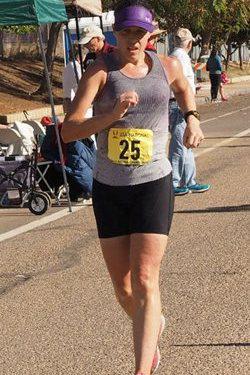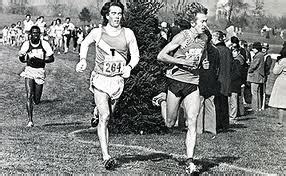 Erin Taylor-Talcott, photo courtesy of USATF.org
Erin Taylor-Talcott, photo courtesy of USATF.org
The 50,000 meter Race Walk is the longest event on the Olympic platform. It has much history and deserves much respect. Race walkers possess the VO2 Max of cross country skiers. Think about walking for nearly four hours at 7 minute per mile pace, and keeping form!
Erin Taylor-Talcott is a trail blazer. 1956 Olympian Race Walker Elliott Denman wrote this piece on Ms. Taylor-Talcott, who will make history in Rome the weekend of May 7-8!
ERIN TAYLOR-TALCOTT’S LONG WALK
INTO WORLD TRACK AND FIELD HISTORY
By ELLIOTT DENMAN
“I’ve been told more times than I can count what I can’t do,” Erin Taylor-Talcott tells you.
“I’ve been told I can’t race a 50K (which is 31.1 miles.)
” I’ve been told I’ll never be allowed to race in the men’s 50K Olympic Trials.
” I’ve been told I’ll never get equal prize money as the men.”
She’s been told all these things, at various stages of the career that now ranks her as the most successful women’s long-distance racewalker her nation has ever seen.
And she’s kicked sand in the faces of all those nay-sayers at every step on her journey.
They’ve been proven wrong and she’s been proven absolutely right.
The journey has now taken her to Rome, for the 27th edition of the event that was known at its founding in 1961 as the Lugano Cup (as in the Swiss city where it was born); morphed into The World Cup when it came under the IAAF umbrella, and from 2016 on will be known as the IAAF World Race Walking Team Championship.
Seventy-two racewalkers, representing 32 countries, will line up for the start of the 50K race in The Eternal City on Sunday morning.
Seventy-one of them are men. The 72nd is USA’s Erin Taylor-Talcott, the 37-year-old Oregon-reared, Rutgers-schooled, musician (oboe and bassoon) and teacher, resident of Owego, New York, dear wife of Masters walk star Dave Talcott, and proud competing member of the Shore Athletic Club.
The April 18 Boston Marathon was an anniversary salute to the breakthrough achievements of Roberta Gibb and Katherine Switzer. Now, the May 850K race through Rome will be Taylor-Talcott’s own breakthrough day.
“They’ve said there’ll never be an international women’s 50K race walk,” she said. “And everything they said was that I couldn’t do it.
“I fought…. and I won.”
What a battle it’s been, through layer upon layer of USATF and IAAF bureaucracy.
Her arguments were pure sense.
There are 24 standard men’s events on the Olympic and World Championships programs, but just 23 for women. The lone outlier (until Sunday) has been the 50K racewalk.
Some alleged it was just too long and too tough – and too unfathomable – for women to even contemplate. Yes, these were the same arguments used to keep the marathon off-limits to women for years – until Roberta Gibb and Katherine Switzer…and Joan Benoit Samuelson eventually ended that debate forever.
Now, it’s Erin Taylor-Talcott knocking the same argument out of the park.
“I’m currently the US women’s 50K National record holder (4:33:23),” she tells you.
“I raced in the 2012 Men’s 50K Olympic Trials, the first woman to ever race in a men’s Olympic Trials event, and placed sixth among the men.
“I petitioned USATF and (after long discussions within the national governing body’s inner councils) women now receive equal prize money in all track and field events
(yes, even the 50K walk.)
“NACAC (the North American, Central American and Caribbean organizing body) held its first ever regional 50K Women’s Championship in Arica, Chile in May of 2015, which I won.
“But there was one thing that almost everyone said I’d never be able to do. They said I’d never be able to race with the men….”
That discussion ends Sunday morning in Rome.
No doubt about it, Erin Taylor-Talcott will be a long-long way from the front end of the 50K park.
The field includes such male celebrities as Australia’s Jared Tallent; China’s Han Yucheng, Xu Faguang and Zhang Lin; Ecuador’s Andres Chocho; Spain’s Jesus Angel Garcia; Italy’s Alex Schwazer and Marco DeLuca; Poland’s Grzegorz Sudol, and a whole lot more.
India is now a rising power in world racewalking. Ukraine, Mexico, Romania, Guatemala, Czech Republic and a bunch more have solid team entries. Unlike so many other
events in track and field, the racewalks are truly global- the best of the best of all six permanently populated continents will have it out in Rome.
The quickest of them will be expected to finish the 31.1-mile journey some three quarters of an hour ahead of Erin Taylor-Talcott.
But just being on the starting line will make her an all-time winner.
“The 50K race walk is the one inequality left in track and field,” is the point she had driven home consistently over the years. But change that “is” now to “was.”
“The men race it all the way up to the Olympics, along with the 20K. But the women only have one event, the 20K. Events like the Pan Am Cup of Race Walking, the World Team Championships of Race Walking, and the World Championships all have (had) two events for men but only one for women.
“People said, ‘they will never add a woman’s 50K to these events.’ I said, ‘fine, don’t add a women’s event, let men and women compete equally.’
” The idea was (initially) scoffed at. There is no gender–blind competition in (the other events of ) track and field. To many, the idea of a gender blind athletic event was preposterous. “
But it didn’t stay that way forever.
In mid-April 2016, the IAAF released a memo to all its member federations around in the world stating that they had changed the technical details for the men’s 50K race walk. They took out the word “men” so that it is just “the” 50K race walk, making it the first gender-blind competition in track and field.
“This went into effect immediately and thus would make the World Team Championships in Rome eligible under the new rules. Because of the rule change, USATF named me to the 50K race walk team.
“Honestly, that had to be one of the happiest days of my life. After being told for years what I couldn’t do, finally I was getting to do what I dreamed of, competing at the world’s highest level at my favorite event, just like one of the guys. Will I win? No. I’m under no delusions. I will go and race my hardest, and be near the back of the pack, but I will be there.
“And all the other women who have been thinking about doing 50K and all the women who have been asking their federations if they could race 50K but have been told ‘no‘ because it’s a men’s event, they will all be there cheering me on, knowing that soon it can be them.
“And once enough women are out there racing at a high level, then we can have our own division. What a huge step! What an amazing thing! To be able to race, to finally be treated as equal! I can hardly describe what it means to me.
“Every lap of my 50K will be my victory lap! Every second out there will be vindication to those who told me to give up and just be happy racing 20K. I can’t wait to race and I can’t wait to see how the women’s 50K develops.”
One of the finest and most prolific writers in our sport, Elliott Denman has written about our sport since 1956, when he represented the US in 1956 Olympic Games at the 50k race walk, the longest event on the Olympic schedule. A close observer of the sport, Elliott writes about all of our sport, combining the skills of a well honed writer with the style of ee Cummings. We are quite fortunate to have Elliott Denman as a friend and advisor.
View all posts
 Erin Taylor-Talcott, photo courtesy of USATF.org
Erin Taylor-Talcott, photo courtesy of USATF.org 




















